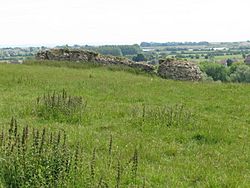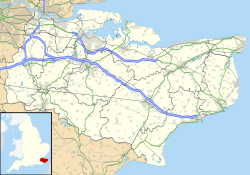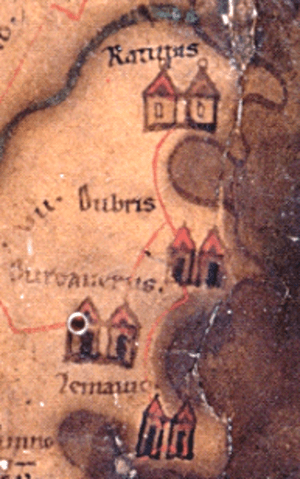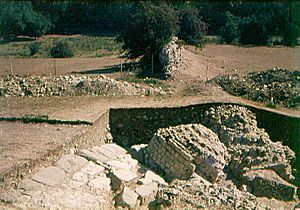Portus Lemanis facts for kids
Quick facts for kids Portus Lemanis |
|
|---|---|
| Kent, England, UK | |

Remains of Portus Lemanis
|
|
|
Location in Kent
|
|
| Coordinates | 51°4′12″N 1°1′8″E / 51.07000°N 1.01889°E |
Portus Lemanis, also known as Lemanae, was an important Roman fort, settlement, and port. It was located in southern Kent, England. The modern village of Lympne gets its name from this ancient Roman port. It was a key part of the Saxon Shore defense system.
Contents
Exploring the History of Portus Lemanis
The first time Portus Lemanis was written about was in the late 200s AD. This was in an old Roman travel guide called the Antonine Itinerary. It said the port was about 68 Roman miles from London (then called Londinium). It was also 16 Roman miles from Canterbury (then called Durovernum Cantiacorum).
Archaeologists have found signs that the site was used even earlier by the Roman navy. They found tiles marked CL BR. This mark shows that sailors or marines from the Classis Britannica (the Roman fleet in Britain) helped build it. An old stone carving from the early 100s AD was also found. It was dedicated to the god Neptune by a Roman officer. This officer was Lucius Aufidius Pantera, a commander of the Classis Britannica.
Who Guarded the Fort?
A Roman document from the 400s AD, called the Notitia Dignitatum, tells us more. It says the fort was guarded by a group of soldiers from Tournai. This unit was called the numerus Turnacensium. Portus Lemanis was part of the Saxon Shore defense system. This system was a chain of forts along the coast. It was commanded by a special officer called a Count. The last time Lemanis was mentioned in Roman writings was in the late 600s AD. By then, Britain was no longer part of the Roman Empire.
Location and How the Fort Was Built
The fort was built on a hill. From this hill, you could see a part of the sea. This area is now dry land, known as the Romney Marsh. There was a harbor to the south and east of the fort. A civilian settlement, called a vicus, also grew up nearby. This village was along the road that led to Canterbury.
Building the Saxon Shore Fort
The fort we see today was built in the late 270s AD. We know this because of its design, which includes towers that stick out from the walls. Sadly, the remains of the fort are not in good condition. The ground, which is mostly clay, has shifted over time. The entire southern side of the fort is gone. Other parts of the fort have moved and tilted. Not much is left of the buildings inside, though there are hints of a Roman bath and possibly the main headquarters.
Exploring the Fort's Remains
This site is still quite a mystery. The only major archaeological digs happened a long time ago, in 1850 and 1852. The main wall of the fort was very strong. It was about 3.9 meters (12.8 feet) wide. Some parts of the wall still stand 6 to 8 meters (20 to 26 feet) high. The wall was built using old materials from earlier structures. It also had layers of brick, including some roofing tiles.
Originally, the fort might have had about 14 towers. There is one main gate left towards the east, and also several smaller back gates called posterns. The fort might have been shaped like an irregular pentagon. It covered an area of about 3.4 hectares (8.4 acres). However, this shape would be unusual for Roman forts, especially for those in the Saxon Shore system.
Visiting Portus Lemanis Today
Locally, the site has been known as Stutfall Castle for a long time. It is on private land, so you cannot visit it directly. However, you can get a good view from a public path that runs along the edge of the hill. There's also another view from a path to the west, though it's not well kept.




